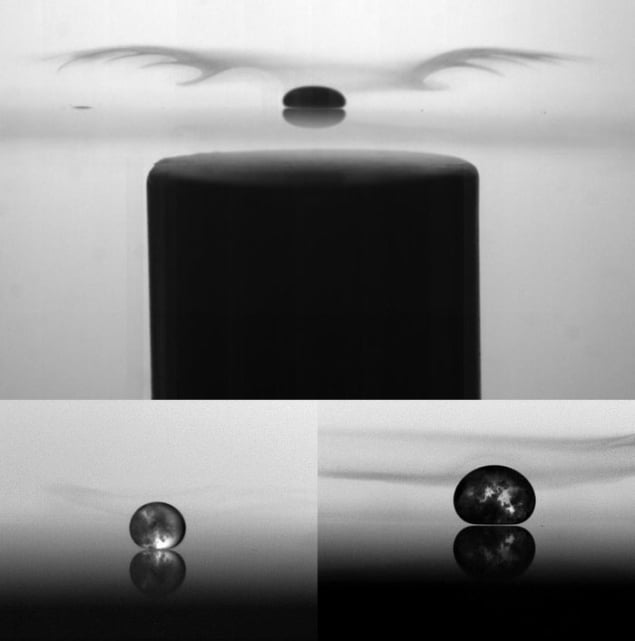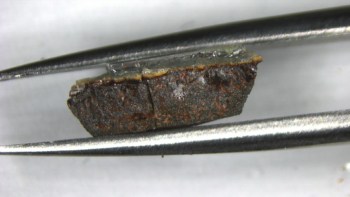
A team of scientists in France has shown that it is possible to control a paramagnetic liquid drop using a magnetic field at room temperature. Using a drop of liquid oxygen, they show that the drop’s trajectory can be controlled using a magnet. The work could help with the development of highly hydrophobic materials and also with the study of very low-friction mechanical systems.
Vapour cushions
The team’s drops are an example of Leidenfrost drops. The Leidenfrost effect is seen when a liquid comes in contact with a surface that is at a significantly higher temperature than the liquid’s boiling point. This produces an insulating layer of vapour that keeps the drop from evaporating rapidly. As there is no contact between the drop and the surface, the friction of the system is reduced dramatically, which makes the drops highly mobile and difficult to control. Indeed, such systems could be considered as the ultimate hydrophobic systems – wherein the liquid is complexly detached from the solid surface.
While this “liquid levitation” was discovered in the 1960s and is used in the some industries, the fundamental physics of the phenomenon have not been studied. In this latest research, David Quéré and colleagues at Ecole Polytechnique in Palaiseau have looked into the forces that drive liquid-oxygen drops, which boil at –183 °C. They have created methods to control the motion of the drops and have also studied how the drops interact with a magnetic field. The research follows on from previous studies by the team and others that looked at developing textured surfaces that make the Leidenfrost drops self-propel with a very high velocity in all directions.
Levitating drops
A highlight of this latest study is the discovery that the drops can be controlled using a simple fridge magnet. In the experiment, the researchers produce the liquid-oxygen drops by pouring a litre of liquid nitrogen into a metal container. “The oxygen drops form as condensation on the outside of the container,” explains Quéré. “In addition to being a really simple process, it’s interesting too, as for once you actually ‘see’ oxygen,” he says. After producing their drops, the researchers placed them on glass plates, with the magnet below.
They found that the magnet had a strong effect on the motion of the drops. Quéré describes the interaction as “rich”. “The system could almost describe celestial mechanics. The magnet acts as the Sun and determines the trajectory of the drop that acts as a planet. But the interactions are even better as we don’t just see elliptical orbits. We see the drops following complex trajectories, forming loops even before breaking away,” he explains.
Sculpting drops
Another interesting aspect of the interaction occurs when a drop passes directly above the magnet. The researchers found that the drop slows down and is nearly trapped by the field. When it breaks away, the shape of the drop is deformed. Quéré points out that this is interesting in a much wider physical context, because the deformation is caused by a transfer of kinetic energy. “Just like when a raindrop hits the ground, it loses most of its energy as it gets deformed upon impact. This transfer of energy is interesting and depends on many parameters,” says Quéré. He told physicsworld.com that the new approach offers a way to study such deformations in a system with negligible friction.
The researchers can change the amplitude of these deformations by changing the strength of the trap – simply by moving the magnet closer to or away from the plate. Quéré says that the team looked into more ways to use a magnet to “sculpt” a drop – for example using an annular (ring-shaped) magnet to get a torus-shaped drop. The researchers then remove the magnet and study the doughnut-shaped drop until it closes again.
Gravitational slingshot
The team also managed to accelerate the drops out of the trap using a method that is normally used to modify the speed of a spacecraft by using the gravity of a planet or a moon to propel it – the so-called gravity-assist technique or the “gravitational slingshot”.
“We think that this system is a great way to study complex celestial mechanics, where the gravitational influence is replaced by the magnetic influence,” says Quéré. “It’s like having a little piece of sky!” Quéré also says that the work will help in further developing non-wetting techniques in micro-engineering, where water and oil travel down the same channel but must not touch.
The paper is to be published in Physical Review E.



